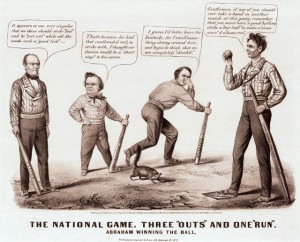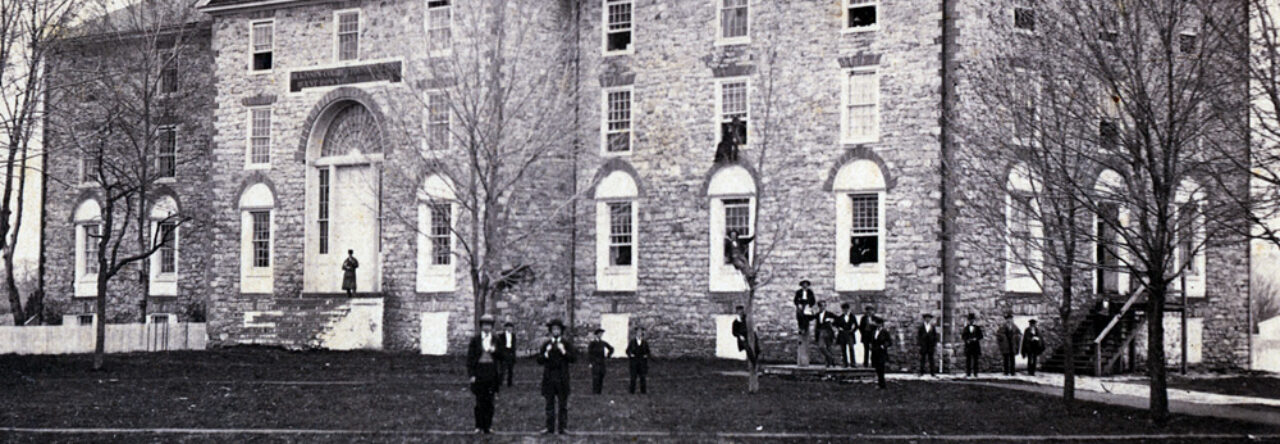 During the Election of 1860, the divided feelings did not stop the election of a new president. The election had several candidates, but the contest was actually between Douglas and Lincoln in the North and West and between Breckinridge and Bell in the South. Many thought the race would be very competitive, but Lincoln ended up dominating. In Cumberland County, Lincoln had an overwhelming victory. The more rural areas such as Hopewell and Fairfield that were mainly farmers, Lincoln won in a significant majority. In urban areas such as the Carlisle District and Newville, the race between the Republicans and Democrats was closer. The chart below gives the reported majority from the different districts in the county. The first column gives the total votes for Lincoln in the district. The second column shows the total of votes for Read, who is the elector for the districts. The third column gives the total votes for Bell, only prevalent in the more urban districts. Most of the rural districts only have votes for Lincoln, allowing him to have no competition in rural areas of Pennsylvania.
During the Election of 1860, the divided feelings did not stop the election of a new president. The election had several candidates, but the contest was actually between Douglas and Lincoln in the North and West and between Breckinridge and Bell in the South. Many thought the race would be very competitive, but Lincoln ended up dominating. In Cumberland County, Lincoln had an overwhelming victory. The more rural areas such as Hopewell and Fairfield that were mainly farmers, Lincoln won in a significant majority. In urban areas such as the Carlisle District and Newville, the race between the Republicans and Democrats was closer. The chart below gives the reported majority from the different districts in the county. The first column gives the total votes for Lincoln in the district. The second column shows the total of votes for Read, who is the elector for the districts. The third column gives the total votes for Bell, only prevalent in the more urban districts. Most of the rural districts only have votes for Lincoln, allowing him to have no competition in rural areas of Pennsylvania.
| Districts | Lincoln. | Read’s Ticket | Bell. | ||
| Carlisle Distict | 886 | 907 | 74 | ||
| Newville | 453 | 570 | 21 | ||
| Upper Allen | 33 | ||||
| Lower Allen | 103 | ||||
| East Pennsboro | 96 | ||||
| Plainfield | 83 | 1 | |||
| Penn Town | 14 | ||||
| Hampden | 19 | ||||
| Hopewell | 20 | ||||
| Mechanisburg | 130 | ||||
| North Cumberland | 32 | ||||
| Monroe | 117 | ||||
| Shippensburg District | 70 | ||||
| Leesburg | 27 | ||||
| Jacksonville | 22 | ||||
| Middlesex | 3 | ||||
| Silver Spring | 169 | ||||
| TOTAL: | 2083 | 1671 | 96 | ||
(Carlisle American, 7 November 1860.)
In the race for Governor, the majority of people in Pennsylvania voted for Andrew Gregg Curtin, a former Dickinsonian, in the election. This proved that the state had gone Republican by not less than 75, 000 Republicans state wide. Cumberland County followed the Pennsylvania results, as Lincoln/Hamlin received 40 percent of the popular vote.
Nationally, Lincoln received a total of 180 electoral votes, while the other candidates combined won 123. Breckinridge thought that he had some support in Pennsylvania, but Cumberland County did not support this assertion.
The Alfred Whital Stern Collection of Lincolniana from the Library of Congress provides images from the election such as political cartoons, newspaper articles, candidate’s addresses and Republican and Democrat tickets. The Library of Congress has a great teacher resource on the Election of 1860. HarpWeek also provides cartoons from the election from Harper’s Weekly and other weekly journals. The

Leave a Reply